Lambeth Hospital
Brook Drive, Kennington, SE11
Medical dates:
Medical character:
Acute, general
The Renfrew Road workhouse
opened in 1871, housing some 820 inmates. It was one of the
earliest pavilion-block style workhouses built in England. In
1876 the Lambeth Infirmary was built next to it on an adjoining site,
with its entrance on Brook Drive.
Gradually the poor able-bodied population of the workhouse decreased, while the poor sick population increased. In 1922 the Lambeth guardians decided to amalgamate the workhouse and the Infirmary. The Lambeth Hospital was the result of this merger. As well as providing in-patient accommodation for the acute and chronic sick, there were two large observation wards and also wards for patients with venereal disease; out-patient clinics were held for antenatal care, eye problems and radiation treatment.
The Hospital came under the control of the LCC in 1930, who decided to close the observation wards and transfer those patients to another hospital. A cardiovascular unit was established and the development of a radiotherapy service was encouraged. In 1936 built a Nurses' Home was built and, in 1938, a maternity block. By 1939 Lambeth Hospital was one of the three largest municipal hospitals in London and could accommodate 1250 patients.
During WW2 the elderly long-term patients were evacuated. The Hospital treated many air-raid casualties and itself suffered bomb damage, with ten members of staff killed. Two ward blocks were destroyed, as were the kitchen, dining room and laundry. Three other ward blocks were severely damaged.
In 1948 the Hospital joined the newly formed NHS. In 1950 it had 492 general and special beds. Money for the repair of war-damaged buildings was scarce, but between 1960 and 1963, a new two-storey building was erected for the kitchens, dining room and offices. An operating theatre block was added in 1967 and a new Renal Unit in 1969.
By 1970 Lambeth Hospital was an acute general hospital with 468 beds. In 1974 it had 416 general and special beds.
The Hospital closed in 1976, when the new North Wing of St Thomas' Hospital opened, and services moved there.
Gradually the poor able-bodied population of the workhouse decreased, while the poor sick population increased. In 1922 the Lambeth guardians decided to amalgamate the workhouse and the Infirmary. The Lambeth Hospital was the result of this merger. As well as providing in-patient accommodation for the acute and chronic sick, there were two large observation wards and also wards for patients with venereal disease; out-patient clinics were held for antenatal care, eye problems and radiation treatment.
The Hospital came under the control of the LCC in 1930, who decided to close the observation wards and transfer those patients to another hospital. A cardiovascular unit was established and the development of a radiotherapy service was encouraged. In 1936 built a Nurses' Home was built and, in 1938, a maternity block. By 1939 Lambeth Hospital was one of the three largest municipal hospitals in London and could accommodate 1250 patients.
During WW2 the elderly long-term patients were evacuated. The Hospital treated many air-raid casualties and itself suffered bomb damage, with ten members of staff killed. Two ward blocks were destroyed, as were the kitchen, dining room and laundry. Three other ward blocks were severely damaged.
In 1948 the Hospital joined the newly formed NHS. In 1950 it had 492 general and special beds. Money for the repair of war-damaged buildings was scarce, but between 1960 and 1963, a new two-storey building was erected for the kitchens, dining room and offices. An operating theatre block was added in 1967 and a new Renal Unit in 1969.
By 1970 Lambeth Hospital was an acute general hospital with 468 beds. In 1974 it had 416 general and special beds.
The Hospital closed in 1976, when the new North Wing of St Thomas' Hospital opened, and services moved there.
Present status (January 2008)
The buildings have mostly been demolished. The water tower and the central part of the old workhouse - the Master's House - survive. The Master's House currently contains units for the Three Boroughs Primary Health Care Trust and the Cinema Museum (April 2008), a charitable organisation found in 1986, but the building is about to be offered for sale.
The Lambeth Community Care Centre opened on part of the site in Monkton Street in 1985. The site also contains the Woodlands Nursing Home.
The reminder of the 1.5 acre site was sold to Bellway Homes in May 2007 for £10m, who have built 115 apartments and are converting the redundant water tower for residential use.
The buildings have mostly been demolished. The water tower and the central part of the old workhouse - the Master's House - survive. The Master's House currently contains units for the Three Boroughs Primary Health Care Trust and the Cinema Museum (April 2008), a charitable organisation found in 1986, but the building is about to be offered for sale.
The Lambeth Community Care Centre opened on part of the site in Monkton Street in 1985. The site also contains the Woodlands Nursing Home.
The reminder of the 1.5 acre site was sold to Bellway Homes in May 2007 for £10m, who have built 115 apartments and are converting the redundant water tower for residential use.
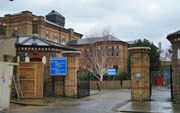
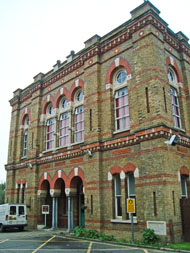
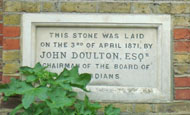
The Master's House with its corner stone dated 1871.
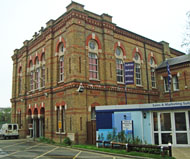
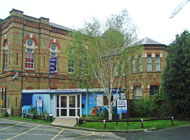
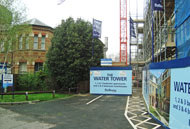
The Bellway Homes Sales and Marketing Suite beside the Master's House.
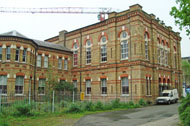
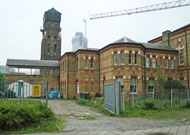
The Master's House with a crane and the water tower shown beyond.
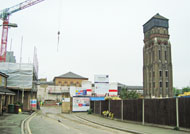
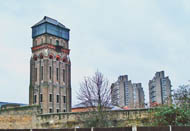
The water tower is being converted into apartments.
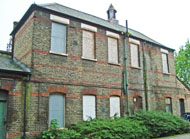

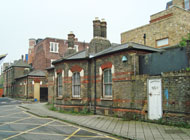
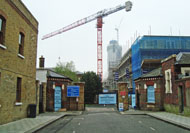
Several old buildings remain, some boarded up.
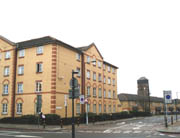
The water tower in the distant background on the right, from Kennington Lane, with new housing in the foreground.
www.a2a.org.uk
www.aim25.ac.uk
www.derelictlondon.com
www.driversjonas.com
www.lambeth.gov.uk
www.slam.nhs.uk
www.workhouses.org.uk
Return to home page